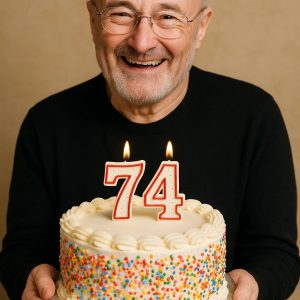Oklahoma City awoke to history this morning. In front of City Hall, under a clear Midwestern sky, the curtain dropped on a masterpiece: a $3 million bronze statue of Blake Shelton, the state’s most beloved son and one of America’s most influential cultural icons.
A Monument of Legacy
Towering twelve feet high, the statue depicts Shelton with a guitar slung across his back, his head slightly lifted, as though singing to eternity. His left hand is outstretched—not in defiance, but in welcome. It is a pose that echoes both his concerts and his character, capturing the spirit of a man who gave his voice not only to music but to the people he loved.
City officials describe the monument as more than art. “This isn’t just bronze,” said Mayor David Holt during the unveiling ceremony. “This is the immortalization of resilience, of pride, and of Oklahoma’s living heartbeat. Blake Shelton isn’t just a singer—he is our story carved into eternity.”
The Voice of Oklahoma
Blake Shelton’s journey began in Ada, Oklahoma, where dirt roads and open skies shaped a boy with dreams bigger than the prairie. Rising through the ranks of Nashville’s competitive scene, Shelton became a household name with hits like Austin and God Gave Me You. But beyond the accolades, beyond the television fame of The Voice, Shelton never abandoned his roots.
Locals recall him returning to Oklahoma after tours, lending his time and money to rebuild schools, fund children’s hospitals, and support struggling farmers. “He always said he belonged to Oklahoma before Oklahoma belonged to him,” shared his mother, Dorothy, her eyes wet with pride.
More Than a Singer
The statue’s plaque calls him a “Voice of Hope.” Those words carry weight, for Shelton’s role extended far beyond the stage. He was known for championing civil rights causes, standing publicly for equality, and ensuring that his concerts were spaces of unity where divisions dissolved into music.
“He had this ability,” Gwen Stefani said during the ceremony, “to take heartbreak, pain, or even national tragedies, and sing them back to us in a way that made us stronger. He never claimed to be a hero, but he gave people courage when they needed it most.”

Humility in Bronze
The irony of such a monumental tribute is that Shelton himself would have shrugged it off. A quote etched into the base of the statue reflects his humility:
“I never thought I’d be petrified — I just wanted to sing my heart out.”
The crowd laughed through tears when Gwen read those words aloud. They knew Shelton’s humor, his charm, his refusal to let grandeur cloud his simple love for music. Yet, even in bronze, his humility radiates.
A $3 Million Masterpiece
Crafted by renowned sculptor James Montgomery, the statue took three years to complete. Montgomery studied hundreds of photos and concert videos, aiming to capture Shelton’s soul rather than just his likeness.
“Every line of bronze is meant to tell a story,” Montgomery explained. “The tilt of his head, the stretch of his hand—it’s the story of a man who gave more than he took.”
Funded by a combination of state grants, private donations, and contributions from country music fans worldwide, the $3 million project symbolizes not extravagance but gratitude. “It’s a people’s monument,” one donor said. “Built by love, for love.”
A Ceremony of Tears and Cheers
The unveiling ceremony drew thousands. Fans traveled from across the nation, some holding candles, others guitars. Veterans in cowboy hats stood beside teenagers in Blake Shelton tour shirts, united by the voice that had been a soundtrack to their lives.
When the curtain fell, the crowd erupted into applause, cheers, and sobs. A choir performed Shelton’s God’s Country, their harmonies rising to the skies as the statue gleamed in the morning light.
A Legacy for Centuries
Officials estimate the statue will stand for centuries, a permanent landmark in Oklahoma City. Schoolchildren will walk past it on field trips, couples will pose beside it on anniversaries, and fans will gather to leave flowers, letters, and cowboy boots at its base.
“This monument isn’t about yesterday,” said Governor Kevin Stitt. “It’s about tomorrow. It’s about ensuring that when future generations ask, ‘Who was Blake Shelton?’ the answer will be standing right here, larger than life.”

Gwen Stefani’s Words
No speech resonated more than Gwen Stefani’s. Standing with her hand on the bronze outstretched palm of her husband’s likeness, she spoke softly:
“Blake taught me that love is louder than fear, that kindness is stronger than criticism. He gave me songs, but more than that, he gave me a home in his heart. Today, this statue isn’t just a monument—it’s a reminder that every note he sang will live forever.”
Her words silenced the crowd before thunderous applause broke out, echoing across downtown Oklahoma City.
Conclusion: Bronze That Breathes
Statues are often cold, distant things. But Blake Shelton’s monument feels alive—alive with stories of resilience, generosity, humor, and heart. It isn’t just a piece of bronze. It’s a symbol of Oklahoma, of America, of a man whose voice carried millions through heartbreak, triumph, and joy.
Blake Shelton, immortalized at 49 in bronze, will not just be remembered as a country music legend. He will be remembered as a pioneer, a philanthropist, and a spirit unafraid to turn life’s pain into beauty.
As the sun set behind Oklahoma City Hall, the bronze caught fire in the golden light. And for a moment, it seemed as if Shelton himself was there—still singing, still giving, still welcoming the world into his story.





